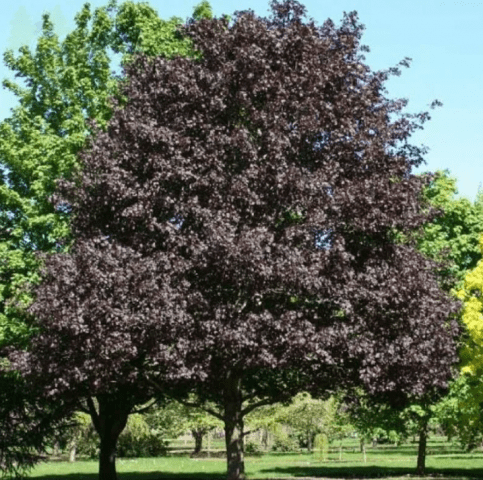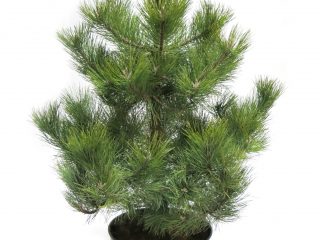Content
Even naturally occurring maple varieties look very impressive due to their original shape and bright autumn leaf color. Breeders managed to further enhance the “natural” decorative effect: they created varieties that are actively used in urban and “private” landscape design. These include the Royal Red maple, which stands out for its very rich shade of leaves.
Breeding history
The Royal Red variety was created “on the basis” of the natural Norway maple (Acer Platanoides) in 1963. His homeland is Oregon (USA), specifically the Pacific Coast Nurseries. The variety can well be called one of the most successful attempts to “modernize” the Norway maple; very few varieties can compete with it in terms of worldwide popularity.
Description of maple Royal red
In terms of cold resistance, according to the local classification, Royal Red maple belongs to USDA zone 4. This means that mature trees winter without damage at temperatures of -29-34 ºС. In very severe and prolonged frosts, it is mainly the annual growth that suffers.Over the next season, the tree recovers quite quickly, and its decorative properties do not suffer in the future.
Royal maple height red
Royal Red maple is quite tall (10-12 m), but at the same time “slender” and graceful tree. The trunk is smooth, covered with dark gray bark with small “wrinkles.” Although, in principle, the height of the tree can be successfully adjusted by pruning. It is often limited at a level of 2-4 m.

In a favorable climate and with quality care, a tree can “stretch” up to 20-25 m
The crown without “outside help” takes on a relatively symmetrical and regular pyramidal (less often tent-shaped) shape. At the bottom it is dense, but not thickened; closer to the top there is greater sparseness.
Leaves
Young, newly opened leaf blades have a deep scarlet, almost “bloody” color. Then the shade gradually becomes darker and more saturated, turning into a red-burgundy-purple. By autumn, the foliage brightens a little again, and an orange-crimson-raspberry undertone appears.

The leaves are large, of a typical shape for the crop - five- or seven-lobed, with pointed “teeth” and deeply cut “notches”
Fruit
Around mid-September, brownish-beige winged seeds ripen. They are quite large (about 5 cm long). In principle, Royal Red maple seeds, especially freshly collected ones, are suitable for propagation, but in practice gardeners rarely resort to this method of obtaining new tree specimens.
Flowering period
Flowers and leaves bloom almost simultaneously - in May. The specific period depends on local climatic conditions. The flowers are 10-12 mm in diameter, yellowish-green, and glow pale golden in the sun.

The flowers are collected in not too dense “erect” corymbose inflorescences
Planting and caring for Royal red maple
When choosing a place to plant a Royal Red maple, you need to consider the following important nuances:
- The plant is light-loving and can adapt to light shade without damage.
- The substrate must be both fertile and sufficiently loose. The optimal pH is slightly acidic or neutral (6.0-7.5).
- The tree has a fairly large crown, so when planting, a minimum of 4 m is left between the seedling and any “obstacle”.
- The culture categorically does not tolerate saline and “heavy” soil. The Royal Red maple also reacts very negatively to improper watering - both drought and regular waterlogging of the soil are harmful to it.

In deep shade, the Royal Red maple develops very slowly, the leaves become smaller and lose their characteristic coloring.
You can plant Royal Red maple in both autumn and spring. The first option is more often chosen by gardeners in the south of Russia, the second - in regions with a temperate and more severe climate.In the fall, the time is calculated so that there are 4-5 weeks left before frosts, in the spring they wait until the likelihood of their “return” is minimized.
The approximate dimensions of the planting hole are 70-80 cm in diameter and 50-60 cm in depth. During its preparation, any drainage material must be poured to the bottom, and the soil is mixed with fertilizers.

Drainage – additional prevention of water stagnation at the roots of the Royal Red maple
Regarding the care of Royal Red maple, the following recommendations can be given:
- Watering. During the first season after planting and in extreme heat (if there is no rain), the plant is watered twice a week. The rest of the time, the intervals are increased to 10-15 days, taking into account the air temperature, frequency and intensity of precipitation. The approximate norm is 20-25 liters per adult tree.
- Feeding. If the fertilizer was applied to the planting hole, the Royal Red maple does not need fertilizing in the first year. Next, a special product for ornamental garden trees is applied annually, in the second half of September. Every spring or once every 2-3 seasons, depending on the initial fertility of the soil, humus or ready-made compost is distributed around the tree trunk circle.
- Mulching. A very useful event that helps the gardener save time on loosening and weeding. Mulch also “retains” moisture in the soil, which allows you to increase the intervals between waterings.
- Prevention of diseases and pest attacks. The experience of Russian gardeners shows that the attack of insects feeding on leaves and plant sap on the Royal Red maple is an extremely rare occurrence. Of the diseases, powdery mildew is the most dangerous for it, so preventive treatments with fungicides are desirable at the beginning and end of the season.
- Trimming.A symmetrical, neat crown is formed with virtually no outside help. The gardener is only required to perform sanitary pruning twice a year. Although, in principle, the tree tolerates even a radical “haircut” well, so it is possible to create the most fantastic configurations. For example, Royal Red maple is often grown on a trunk and turned into a hedge.
- Preparing for winter. The Royal Red maple needs special shelter only if the winter is expected to be very harsh and with little snow. The roots and base of the trunk are “insulated” with mulch, the trunk with several layers of covering material or burlap.

The main requirement for autumn fertilizing is the absence or minimum nitrogen content.
Reproduction of maple Royal red
New copies of Royal Red maple can be obtained in three ways:
- Vaccination on standard. A method for specialists and an amateur gardener to “perform an operation” at home and achieve success is almost impossible.
- Growing from seeds. The method is long and labor-intensive. In addition, it does not guarantee the preservation of varietal characteristics, because the Royal Red maple is not a natural, but a variety of crop developed by breeders. In such plants, “descendants” extremely rarely “inherit” the appearance and other features of their “ancestors”.
- Cuttings. Planting material (the top or middle part of a young shoot up to 20-25 cm long with 2-3 leaf buds) is harvested in the first half of July. Root the cuttings in any moisture-intensive and loose substrate, creating a “greenhouse” for them and providing them with long daylight hours.

In stores and nurseries, with very rare exceptions, Royal Red maple seedlings obtained as a result of grafting onto a standard are sold
Application in landscape design
The variety is consistently in demand in landscape design due to its year-round decorative properties. However, the tree looks especially impressive in the spring, when the pale golden flowers contrast with the red foliage of the Royal Red maple.
Most often it is used for:
- single plantings against the backdrop of a well-groomed lawn;
- group compositions where Royal Red maple is complemented by decorative conifers;
- formation of hedges, edging of garden alleys;
- decorating rock gardens and rockeries.

The tree looks advantageous in almost any “location” and harmoniously “fits” into different concepts and styles of landscape design
Conclusion
Royal Red maple as an element of landscape design in Russia is not nearly as popular as in Asia, North America and Europe. However, this variety is definitely worth a closer look. A mature tree looks very impressive, but at the same time elegant and even graceful. And in terms of the brightness of the color of the leaves, it has practically no “competitors”. The impressive appearance is successfully complemented by good cold resistance and ease of care.








